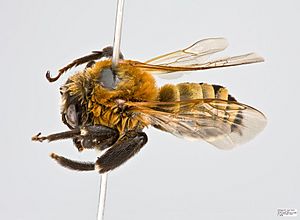Ptilothrix facts for kids
Quick facts for kids Ptilothrix |
|
|---|---|
 |
|
| P. relata male | |
| Scientific classification |
|
| Kingdom: | Animalia |
| Phylum: | Arthropoda |
| Class: | Insecta |
| Order: | Hymenoptera |
| Family: | Apidae |
| Tribe: | Emphorini |
| Genus: | Ptilothrix Smith, 1853. |
Ptilothrix is a group of bees (a genus) that belongs to the Apidae family. This family also includes bumblebees, honeybees, and stingless bees. Ptilothrix bees are usually between 7 and 15 millimeters long. They are solitary bees, meaning they live alone and do not form large colonies like honeybees. These bees build their nests in the ground.
Ptilothrix bees have special long hairs on their back legs called scopae. These hairs help them collect a lot of pollen to feed their young. These bees are picky eaters! They mostly collect pollen from specific plant families like Malvaceae (mallow family), Convolvulaceae (morning glory family), and Cactaceae (cactus family). You can find Ptilothrix bees in North and South America.
Contents
Types of Ptilothrix Bees
There are many different kinds of Ptilothrix bees. Here are some of the known species:
- Ptilothrix albidohirta
- Ptilothrix bombiformis (also called the hibiscus bee or rose-mallow bee)
- Ptilothrix chacoensis
- Ptilothrix concolor
- Ptilothrix corrientium
- Ptilothrix fructifera
- Ptilothrix fuliginosa
- Ptilothrix heterochroa
- Ptilothrix lynchii
- Ptilothrix nemoralis
- Ptilothrix nigerrima
- Ptilothrix plumata
- Ptilothrix relata
- Ptilothrix scalaris
- Ptilothrix sumichrasti
- Ptilothrix tricolor
- Ptilothrix vulpihirta
Life Cycle and Behavior
Ptilothrix bees are solitary, which means each female bee builds her own nest and raises her own young. They don't have a queen or worker bees like honeybees. Female Ptilothrix bees dig nests in hard-packed soil. Inside the nest, they create special rooms called brood cells.
Each brood cell gets an egg and a ball of pollen and nectar. This food provides nutrients for the young bee as it grows. When the young bees are ready, they emerge from the nest as adults. Sometimes, the nest entrance is covered with soil to keep it safe.
Dealing with Danger
Young bees in the larval stage can be eaten by predators like parasitoid wasps, fire ants, and assassin flys. To survive these threats, young Ptilothrix bees can delay their growth. This is called diapause. It means they wait to mature until the weather and environment are safe.
Some Ptilothrix species build their nests very close to each other. This creates a large group of individual nests in one area.
Male Bee Behavior
Male Ptilothrix bees often wait at flowers to find females for mating. Studies show that male bees can help pollinate flowers a lot, even more than females sometimes! For example, one study found that male bees made up only a small part of visits to Hibiscus flowers. However, they helped transfer a large amount of pollen. This means their active behavior helps flowers make more seeds.
Physical Features
Ptilothrix bees are fairly large, ranging from 7 to 15 millimeters long.

The long, coarse hairs on their legs, called scopae, are very helpful. They are great for collecting large pollen grains, like those from the Malvaceae family. These special scopae might help Ptilothrix bees compete better with other bees, like honeybees, for food.
Scopae also help Ptilothrix bees stay cool in hot, dry places. They can reflect sunlight and help the bees release moisture. Unlike honeybees or bumblebees, which have smooth pollen baskets, Ptilothrix bees use their hairy legs. Interestingly, Ptilothrix bees can even walk on the surface of water!
Where They Live
You can find different species of Ptilothrix bees across North and South America. One species, Ptilothrix bombiformis, is the only one found east of the Mississippi River in North America. Like most bees, they are more common in areas outside of the very hot tropical regions.
Building a Nest
Ptilothrix bees are sometimes called "chimney bees." This is because the entrance to their nests can look like a small chimney or turret sticking out of the ground. Female bees build these nests in hard-packed soil.
Each nest can have one or many brood cells. To dig in the hard soil, the female bee often carries water to soften the ground. After digging, she lines the inside of the burrow with wax or a special substance to make it stronger.
Nest Survival
Building a nest is hard work, and not all nests survive. For example, about 57% of P. bombiformis nests survive each season. The main reasons nests fail are often due to fungus or eggs not hatching. For P. plumata bees in Brazil, about 88% of nests might not survive. This is often due to predators like fire ants or other parasites. Female bees can build several nests and usually avoid building during the rainy season.
Ptilothrix females have developed ways to protect their nests. P. plumata bees can delay when their young hatch, depending on the environment and predators. If a female bee sees parasites or predators near her nest, she might cover the entrance or shake her body to scare them away. Sometimes, females even start building a nest and then abandon it if they sense danger.
Pollination Habits
Ptilothrix bees are often oligolectic. This means they prefer to collect pollen from only a few specific types of plants. For example, P. plumata mostly collects pollen from plants in the Malvaceae family, especially Pavonia species. About 90% of the pollen found in P. plumata nests comes from Pavonia plants.
Even if a bee specializes in one plant, it doesn't always mean it's the best pollinator for that plant. Sometimes, generalist bees (who visit many types of flowers) can be just as good, or even better, at pollinating. For Ptilothrix bees, their effectiveness as pollinators can depend on the size of the pollen grains. Also, male bee competition for mates can sometimes lead to more pollination than the female's pollen collecting.

